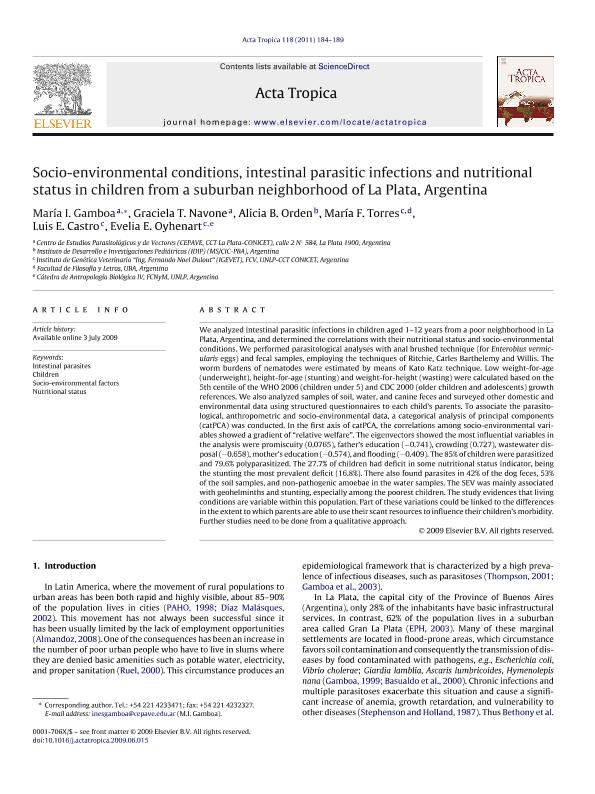Artículo
Socio-environmental conditions, intestinal parasitic infections and nutritional status in children from a suburban neighborhood of La Plata, Argentina
Gamboa, María Inés; Navone, Graciela Teresa ; Orden, Alicia Bibiana
; Orden, Alicia Bibiana ; Torres, María Fernanda
; Torres, María Fernanda ; Castro, Luis Eduardo; Oyhenart, Evelia Edith
; Castro, Luis Eduardo; Oyhenart, Evelia Edith
 ; Orden, Alicia Bibiana
; Orden, Alicia Bibiana ; Torres, María Fernanda
; Torres, María Fernanda ; Castro, Luis Eduardo; Oyhenart, Evelia Edith
; Castro, Luis Eduardo; Oyhenart, Evelia Edith
Fecha de publicación:
06/2011
Editorial:
Elsevier Science
Revista:
Acta Tropica
ISSN:
0001-706X
Idioma:
Inglés
Tipo de recurso:
Artículo publicado
Clasificación temática:
Resumen
We analyzed intestinal parasitic infections in children aged 1-12 years from a poor neighborhood in La Plata, Argentina, and determined the correlations with their nutritional status and socio-environmental conditions. We performed parasitological analyses with anal brushed technique (for Enterobius vermicularis eggs) and fecal samples, employing the techniques of Ritchie, Carles Barthelemy and Willis. The worm burdens of nematodes were estimated by means of Kato Katz technique. Low weight-for-age (underweight), height-for-age (stunting) and weight-for-height (wasting) were calculated based on the 5th centile of the WHO 2006 (children under 5) and CDC 2000 (older children and adolescents) growth references. We also analyzed samples of soil, water, and canine feces and surveyed other domestic and environmental data using structured questionnaires to each child's parents. To associate the parasitological, anthropometric and socio-environmental data, a categorical analysis of principal components (catPCA) was conducted. In the first axis of catPCA, the correlations among socio-environmental variables showed a gradient of " relative welfare" The eigenvectors showed the most influential variables in the analysis were promiscuity (0.0765), father's education (-0.741), crowding (0.727), wastewater disposal (-0.658), mother's education (-0.574), and flooding (-0.409). The 85% of children were parasitized and 79.6% polyparasitized. The 27.7% of children had deficit in some nutritional status indicator, being the stunting the most prevalent deficit (16.8%). There also found parasites in 42% of the dog feces, 53% of the soil samples, and non-pathogenic amoebae in the water samples. The SEV was mainly associated with geohelminths and stunting, especially among the poorest children. The study evidences that living conditions are variable within this population. Part of these variations could be linked to the differences in the extent to which parents are able to use their scant resources to influence their children's morbidity. Further studies need to be done from a qualitative approach.
Archivos asociados
Licencia
Identificadores
Colecciones
Articulos(CEPAVE)
Articulos de CENTRO DE EST.PARASITOL.Y DE VECTORES (I)
Articulos de CENTRO DE EST.PARASITOL.Y DE VECTORES (I)
Articulos(IGEVET)
Articulos de INST.DE GENETICA VET ING FERNANDO NOEL DULOUT
Articulos de INST.DE GENETICA VET ING FERNANDO NOEL DULOUT
Citación
Gamboa, María Inés; Navone, Graciela Teresa; Orden, Alicia Bibiana; Torres, María Fernanda; Castro, Luis Eduardo; et al.; Socio-environmental conditions, intestinal parasitic infections and nutritional status in children from a suburban neighborhood of La Plata, Argentina; Elsevier Science; Acta Tropica; 118; 3; 6-2011; 184-189
Compartir
Altmétricas



